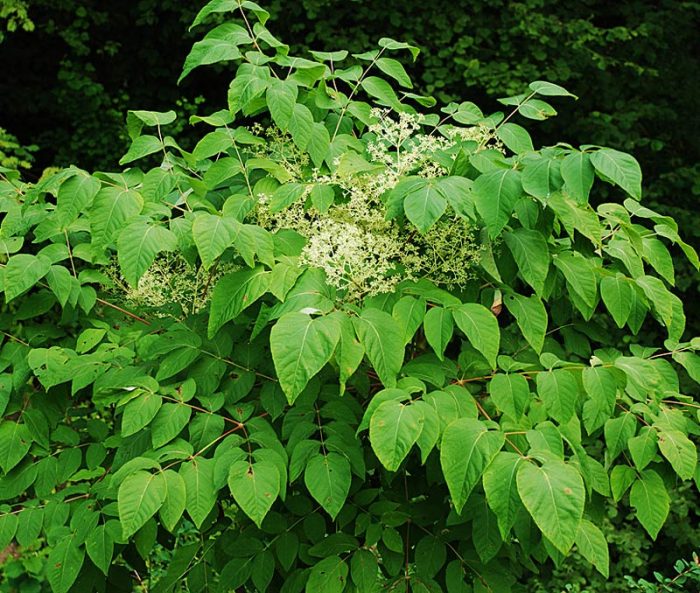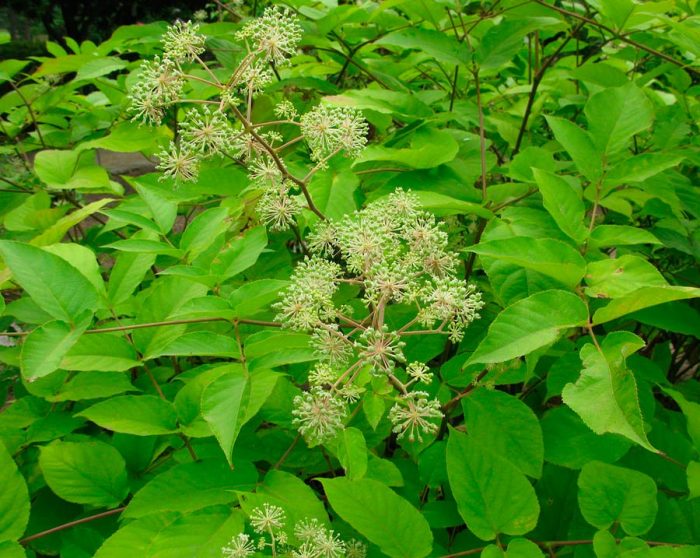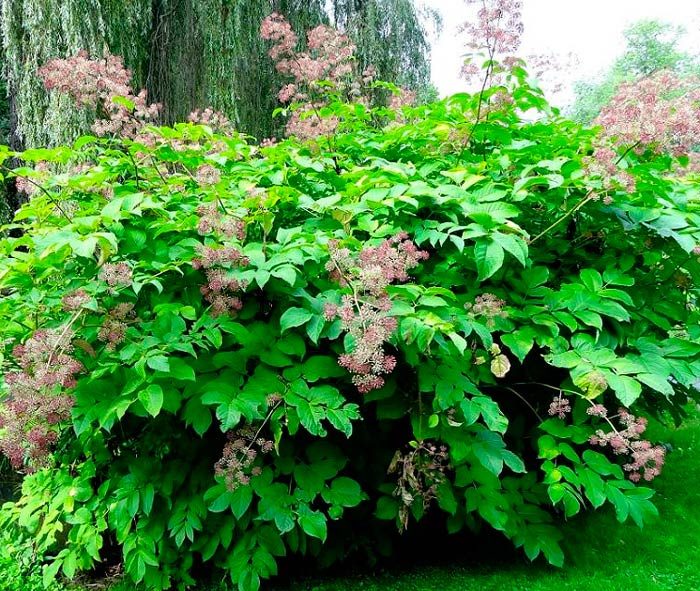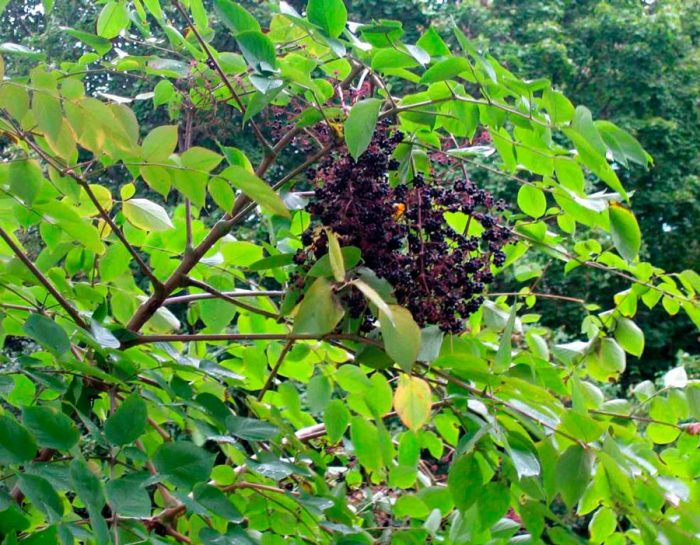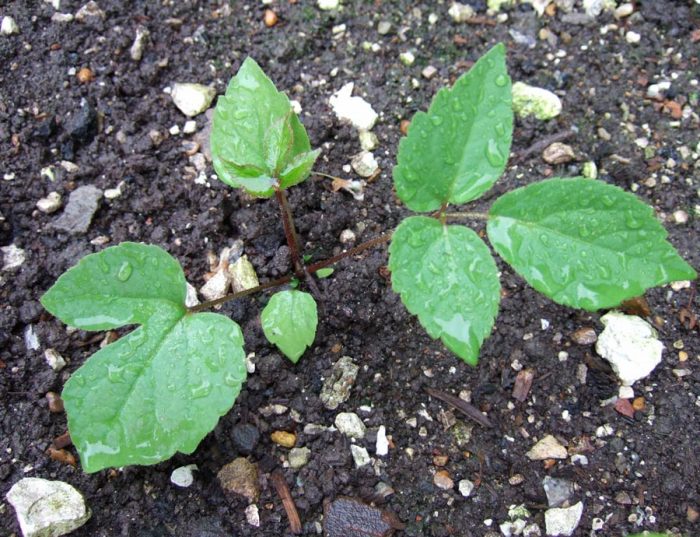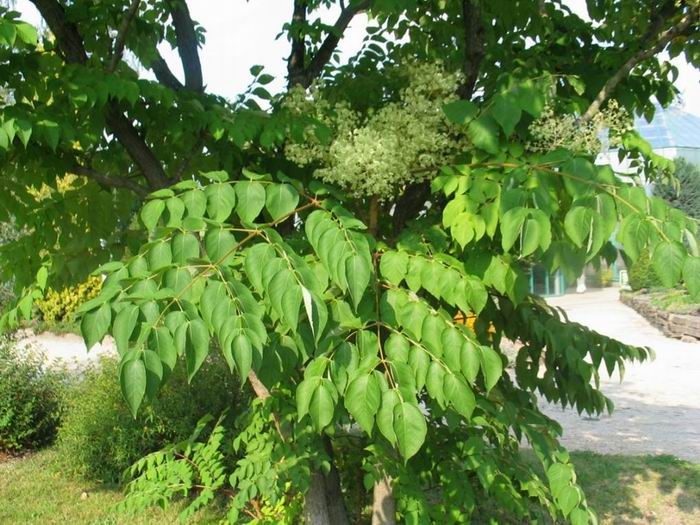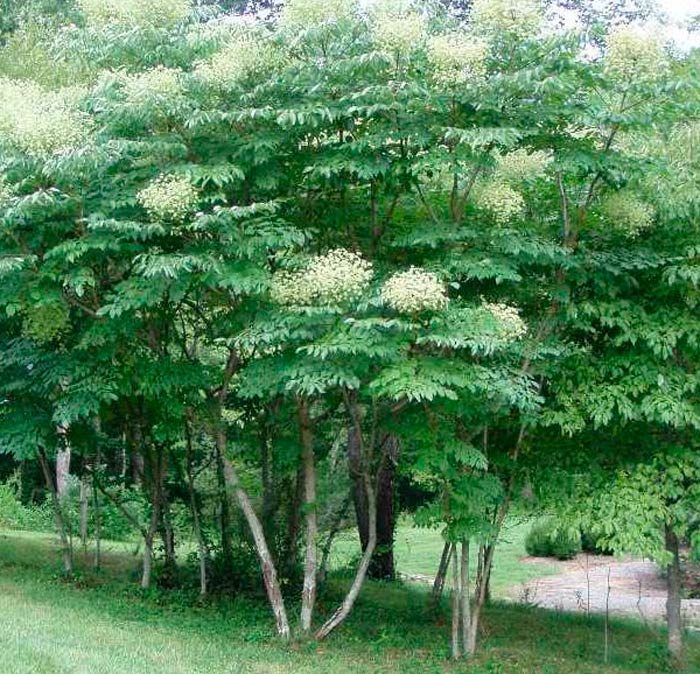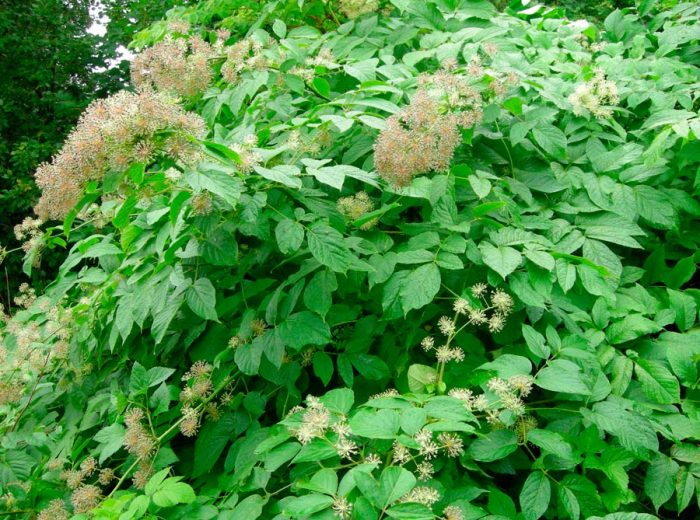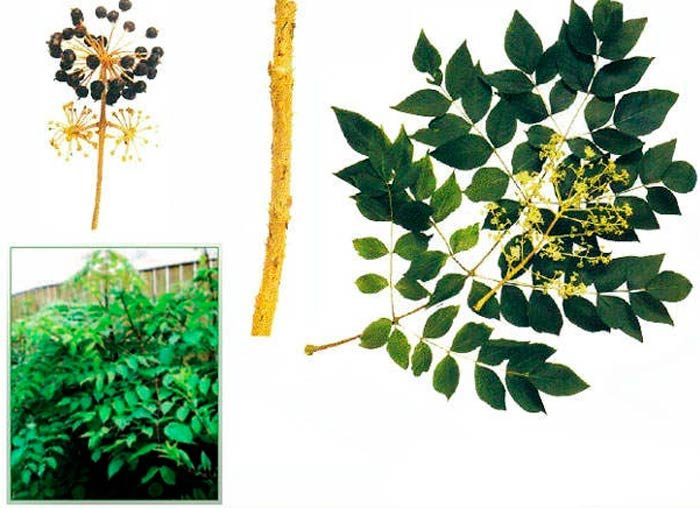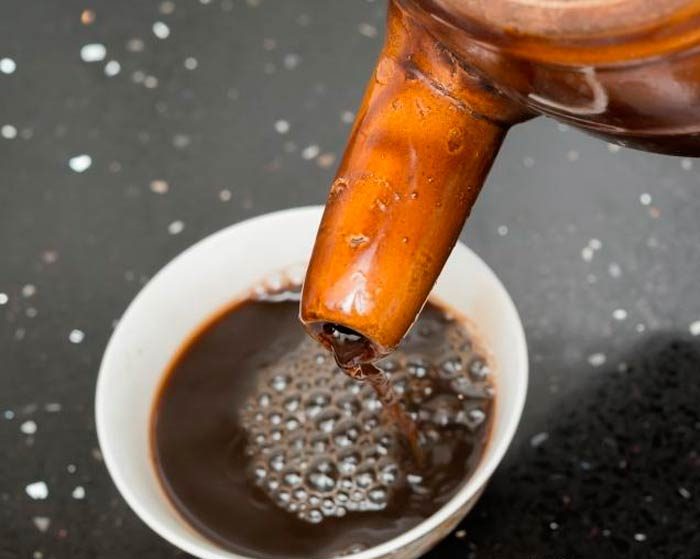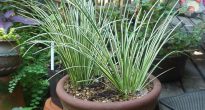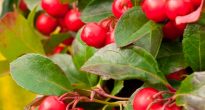The flowering plant Aralia is a member of the Aralia family. Under natural conditions, it can be found in subtropical and tropical regions, and even partially in places with a temperate climate in Australia, Asia, Central and North America. This genus unites about 70 species, but only Manchurian Aralia is cultivated by gardeners as a medicinal, ornamental and melliferous plant.
Content
Features of aralia
Aralia Manchurian, or high is a tree or shrub, characterized by rapid growth, and its height can vary from 1.5 to 12 meters. The straight trunk reaches up to 0.2 m in diameter. The radial root system is placed in the ground at a depth of 10 to 25 centimeters. An interesting fact is that at a distance of 2 to 5 m from the trunk, the beginning of strong branching of the roots is noted, while they sharply bend and go down to a depth of about 0.6 m.And on the surface of the leaf petioles and on the trunk there are a huge number of sharp thorns ... The complex double-pinnate leaves include from 2 to 4 pairs of lobes, and they consist of 5-9 pairs of leaves. The large apical inflorescences, reaching 0.45 m in diameter, include umbrellas, consisting of small flowers of white or cream color. The fruit is a berry of black and blue color, reaching 0.3–0.5 cm in diameter, inside which there are 3–5 seeds. The first flowering of the aralia tree, which grows in the wild, is observed only in the 5th year of growth. Such a plant blooms in July and August, and the ripening of the fruits is noted in September and October.
Growing aralia in the garden
Planting aralia in the ground
You can plant aralia on your garden plot in early spring before the buds swell on the trees, or in the fall, when the leaf fall ends. For such a plant, a well-moistened area is perfect, illuminated by the sun only until 11-12 hours. Before starting planting, you need to make sure that the area is completely cleared of such harmful insects as the May beetle, bear, etc. in that they can severely injure the root system of a tree. The site is subjected to digging or plowing to the depth of a shovel bayonet, then it is left alone for 7 days so that the soil has time to ventilate well.After that, it is harrowed and a mixture consisting of rotted manure and peat-manure compost (1: 1) is evenly placed on the surface, then it is dug up again.
The depth of the planting pit should be equal to 0.35-0.4 m, while in diameter it should reach 0.7-0.8 m. The bottom of the pit should be covered with nutritious soil from the upper layer, mixed with fertilizers, while the thickness of the layer should be from 10 to 15 centimeters. After that, a two-year-old seedling is placed in the middle of the hole, when its root system is neatly straightened, all voids must be covered with soil. After planting, the near-stem circle is compacted, and then the plant is well watered. If several seedlings are planted at once, then a distance of 2-3 m is left between them, while the row spacing should be 3-3.5 m.
Aralia care in the garden
It is quite easy to grow aralia in your garden. She will require the greatest attention to herself in the first year after planting in open ground. When the bush is planted, the surface of its trunk circle must be covered with a layer of mulch (peat crumb), while its thickness should be about 20 mm. Thanks to this, the plant will take root faster and its growth will improve, so next year the growth of its aerial part will be from 25 to 30 centimeters. Watering is carried out only when there is a prolonged dry period, while 10 to 20 liters of water are poured under one plant, depending on its age. During the growing season, the surface of the trunk circle must be loosened several times, while remembering that this is done very carefully, since the aralia root system growing near the trunk is located very close to the soil surface. Simultaneously with loosening, it is necessary to weed, and also cut out all unnecessary growth.
Every year, at the beginning of intensive growth and during the formation of buds, the plant is recommended to be fed with a nutrient solution consisting of water (8 parts) and slurry or mullein (1 part). Aralia also responds well to feeding with Nitroammofosky, its solution is prepared according to the instructions attached to the tool. It is recommended to apply such top dressing under the plant alternately with organic fertilizer. In the spring, before the sap flow begins, it is necessary to prune the tree for sanitary purposes, for this, all dry, injured, disease-affected or frost-affected branches and stems, as well as those that grow deeper into the crown, are removed.
Reproduction methods
For reproduction of such a plant, gardeners use the seed method, as well as the vegetative method (by root cuttings). Seeds sprout for a very long time, as a rule, seedlings appear only in the third year after planting, while one should not forget to systematically water the garden bed, otherwise the seeds may not sprout at all. Such tight germination is due to the fact that the embryos of seeds are underdeveloped, like those of ginseng seeds, at first they ripen in the soil, and only after a while their growth begins.
It is much easier to propagate such a plant by root suckers formed on those roots that are located superficially. Wait until the height of the offspring is 25 centimeters, its separation from the parent bush is carried out in the first days of October. By this time, he should have formed his own root system. After the offspring is removed from the soil, it is planted in a permanent place (planting rules are described in detail above).
Aralia pests and diseases
Such a plant is highly resistant to fungal diseases. Problems can arise only if there is a systematic stagnation of water in the root system.
Pests that live underground are very dangerous for the aralia, namely: the larvae of May beetles, wireworms and bears. In this regard, it is so important to try to remove these harmful insects from the site before planting.Slugs can also harm such a tree, they can be collected by hand or use traps, for this they dig a glass jar into the ground up to the very neck, while it must be filled 1/3 of it with beer or fermented compote. Pests will creep into the scent and fall into a jar, from which they can no longer get out.
Types and varieties of aralia with photos and names
In addition to Manchurian aralia, or high gardeners, other types of such a plant are grown.
Aralia spiny (Aralia spinosa)
This species is native to the eastern part of North America, while in nature it prefers to grow on river banks. The height of this tree is about 15 meters, while at first its growth is very active, but then it becomes slower. Fruiting of such a plant begins at 5 or 6 years. This species differs from the Manchurian Aralia by higher frost resistance.
Aralia schmidtiana, or heart-shaped aralia (Aralia cordata)
Under natural conditions, this species is found in forest glades, edges and slopes of the mountains of the Far East. It is a perennial herb that is about two meters high and has a fragrant fleshy rhizome. Dlinnochereshkovye three times or twice pinnately complex leaf plates in length reach about half a meter. Apical panicles consist of umbellate inflorescences, in turn, they include whitish-yellow or whitish-green flowers.
Gardeners cultivate not only the Manchurian Aralia species, but also its decorative forms, of which there are several:
- Subinermis - such a plant has very few or no thorns at all.
- Pyramidalis - the shape of the plant is pyramidal, its leaf plates are small.
- Canescens - on the seamy surface of the sheet plates there is a thick coating, consisting of a pile of pale yellow color.
- Aureo-variegata - the height of the prickly aralia is about 3 meters, while its crown reaches 2.5 meters across. The composition of the leaf plate includes a large number of small leaves, while while they are young, there are spots on their surface, and an intermittent strip of light color passes along the edge. The length of the leaf plates in the lower part of the bush is about 100 centimeters, while their width varies from 70 to 80 centimeters. In autumn, the foliage turns pale red, while the fruits of a dark blue color look very impressive against their background.
- Variegata - the height of such a plant, which is characterized by slow growth, is about three meters, while the surface of the trunk is covered with large thorns. Large openwork feathery leaf plates of a whitish-silver color in length reach about 100 cm.
Properties of aralia: harm and benefit
Useful properties of aralia
The roots of aralia high contain essential oil, starch, proteins, carbohydrates, alkaloids, triterpene saponins, mineral compounds, resins, trace elements, glycosides, and also aralozoids A, B and C. The stems and foliage contain organic acids, alkaloids, carbohydrates, flavonoids, anthocyanins, triterpenoids, and essential oil. And the seeds contain linoleic and octadecene fatty acids.
Means made on the basis of aralia are used for diabetes mellitus, post-influenza asthenia, impotence, and also physical and mental fatigue. These drugs have a stimulating effect on the central nervous system, while they are more effective than products from ginseng. In alternative medicine, such a plant has been used for a long time, it is used to treat skin diseases that are associated with metabolic processes, kidney diseases, schizophrenia, hypotension, atherosclerosis and diabetes mellitus. It should be borne in mind that the products made on the basis of aralia have a cardiological effect, but they do not have a strong effect on blood pressure. For medicinal purposes, tincture of aralia, made from the roots, and Sparal tablets, which have a tonic effect, are used.They also prepare a decoction of the roots, which is used to treat diabetes mellitus, enuresis, colds, inflammation of the mouth and gastrointestinal diseases.
Aralia root decoction
To prepare the decoction of the roots, take 150 milligrams of hot water and 20 grams of crushed aralia roots. The mixture must be boiled over low heat, tightly closing the container with a lid, for 30 minutes, after which it must be cooled for 10 minutes at room temperature. The strained infusion should be stored in the refrigerator for no more than 3 days. Drink the remedy three times a day before meals, 1 tbsp. l.
Aralia root tincture
To prepare a tincture, you need to mix 40 grams of chopped roots with 1 tbsp. alcohol (70%). The vessel is tightly closed and removed for half a month to infuse in a cool and dark place. The finished product has an amber color, specific aroma and pleasant taste. They drink it 3 times a day with meals, 35 drops for 4 weeks. But if there is a predisposition to hypertension, then the drug is drunk twice a day, 10 drops for 21 days.
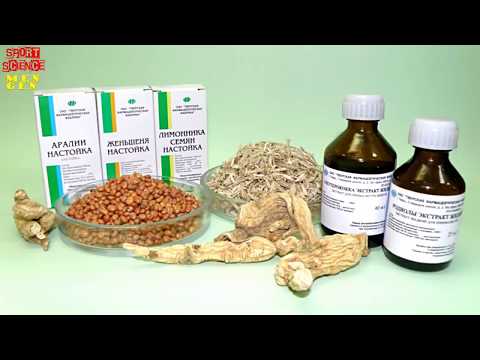

Watch this video on YouTube
Contraindications
Any products made on the basis of aralia should be drunk only as directed by a qualified specialist and strictly under his supervision. It is strictly forbidden to use them for people suffering from hypertension, epilepsy, as well as sleep and nervous system disorders. It is not recommended to take such funds in the evening. You must be very careful, because any of the parts of this plant contains toxins, if poisoned with them, bleeding, respiratory failure, and in some cases loss of consciousness are observed.

